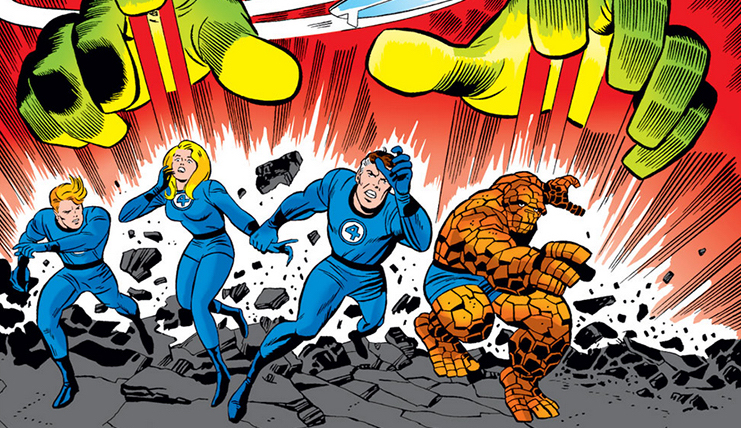One of comics’ greatest inkers, and one of the last links to the Silver Age, has died.

Joe Sinnott, best known for his collaborations with Jack Kirby on Fantastic Four in the ’60s, has died at the age of 93.
Sinnott had a remarkable career as a Marvel Bullpen mainstay beyond inking Kirby, working with the likes of John Romita, John Buscema, George Perez, Bill Sienkiewicz, Rich Buckler and others.
“It with great sorrow that we must announce the passing of Joltin’ Joe Sinnott on June 25th at 8:40am at the age of 93. He went peacefully with the knowledge that his family, friends, and fans adored him,” reads a message on Sinnott’s Facebook page. “He enjoyed life and was drawing up until the end. He always loved hearing from all of you and having your comments read to him. Each and every one of you were special to him.”
We’ve posted quite a bit about Sinnott over the years and below are links to some favorites:
—
LINKS
— JOE SINNOTT: I Barely Knew JACK KIRBY. Click here.
— 13 FANTASTIC COVERS: A JOE SINNOTT Birthday Celebration. Click here.
— KIRBY 100: SINNOTT & ROYER — The Hands of the King. Click here.
— When JOE SINNOTT ‘Met’ the BEATLES. Click here.
— A FANTASTIC Christmas With JOE SINNOTT, by RON MARZ. Click here.

June 25, 2020
I enjoyed reading about him in an Alter Ego interview. He liked Bing Crosby, huge fan! Me too. RIP, Joe.
June 25, 2020
My essay on Sinnott for the book Brush Strokes with Greatness (TwoMorrows, 2007):
When discussing the art of comic books, inevitably the discussion encompasses the twin art forms of penciling and inking, each discipline defined by disparate ends and means, yet so united in their common graphic goal that, when each are at their best, they comprise a yin-yang of perfectly balanced artistic collaboration.
While a great penciller must provide the essential framework of the art, it is up to the inker to not merely trace the pencils with India ink in a robotic display of mimicry, but, by intuitively understanding the uniqueness of the pencils, lend them their proper and correct shape and form, and thus, metaphorically bring them to life.
The history of comic book art is peppered with but a handful of great penciller-inker collaborators, teams who demonstrated, by their artistic prowess, this understanding of their respective roles in the creative end product: Ross Andru and Mike Esposito; Curt Swan and George Klein; Carmine Infantino and Murphy Anderson; Gene Colan and Tom Palmer; and Jack Kirby and Joe Sinnott.
Sinnott fortuitously began inking Kirby on **The Fantastic Four** in late 1965, right when the King embarked on what is arguably the greatest phase of his long career, the full flowering of his creative dynamism exploding the Marvel Universe. Coincidentally during this fertile period, Kirby also developed the many artistic tropes and stylized delineations of speed, power, and energy (“Kirby Krackle”) that have since become graphic standards for generations of comic artists.
Sinnott was there to ink and codify it all, giving Kirby’s complex and sprawling pencils a sensitive, flexible contour and attention to detail that his FF predecessors, Dick Ayers, Chic Stone and Vince Colletta could never have. They were all too one-dimensional: Ayers too heavyhanded with his brush, Stone too cartoony with his uniformly thick outlines, and Colletta too finelined with his scratchy pen (better suited to Kirby’s Thor work) to give Kirby’s new, multi-dimensional pencils the discriminatingly detailed and time-consuming inking they deserved.
Sinnott had in his inking arsenal what those others didn’t: both a bold brushline that was able to give Kirby’s supersized figures the heft and weight they commanded, as well as a fine penline that seemingly never missed the tiniest of dots in Kirby’s Krackle or a single rivet in the King’s outrageous, outsized technology. Sinnott’s brushline also had a natural thick-thin range to properly finesse Kirby’s true graphic signature, the omnipresent squiggle, found on everything from musculature to machinery, as no other inker had before or since.
Of course, aficionados of Mike Royer’s inking of Kirby at DC Comics in the 1970s might disagree. They claim Royer’s inks were the truest to Kirby’s pencils, and have cited Kirby’s own endorsement of Royer’s work as such. While it is true that Sinnott would often “fix” details of Kirby’s work that Kirby would either overlook or pencil sloppily—like crooked eyeballs or costume details—Royer’s more so-called “faithful” inking indirectly exposed a harsher aspect of Kirby’s pencils, a rough-hewn quality that, in its uniformity of rendering by Royer, lacked depth from foreground to background. Nevertheless, Royer has his adherents, and, while such a subjective argument can never be settled, I maintain Sinnott to be Kirby’s greatest inker.
And if Kirby is indeed the greatest penciller in comic book history, and his FF work his greatest single body of work, then Joe Sinnott can justifiably stake a claim as the greatest inker in the history of the medium.
June 25, 2020
R.I.P., Mr. Sinnott. Your legacy in the comics industry will never be forgotten.